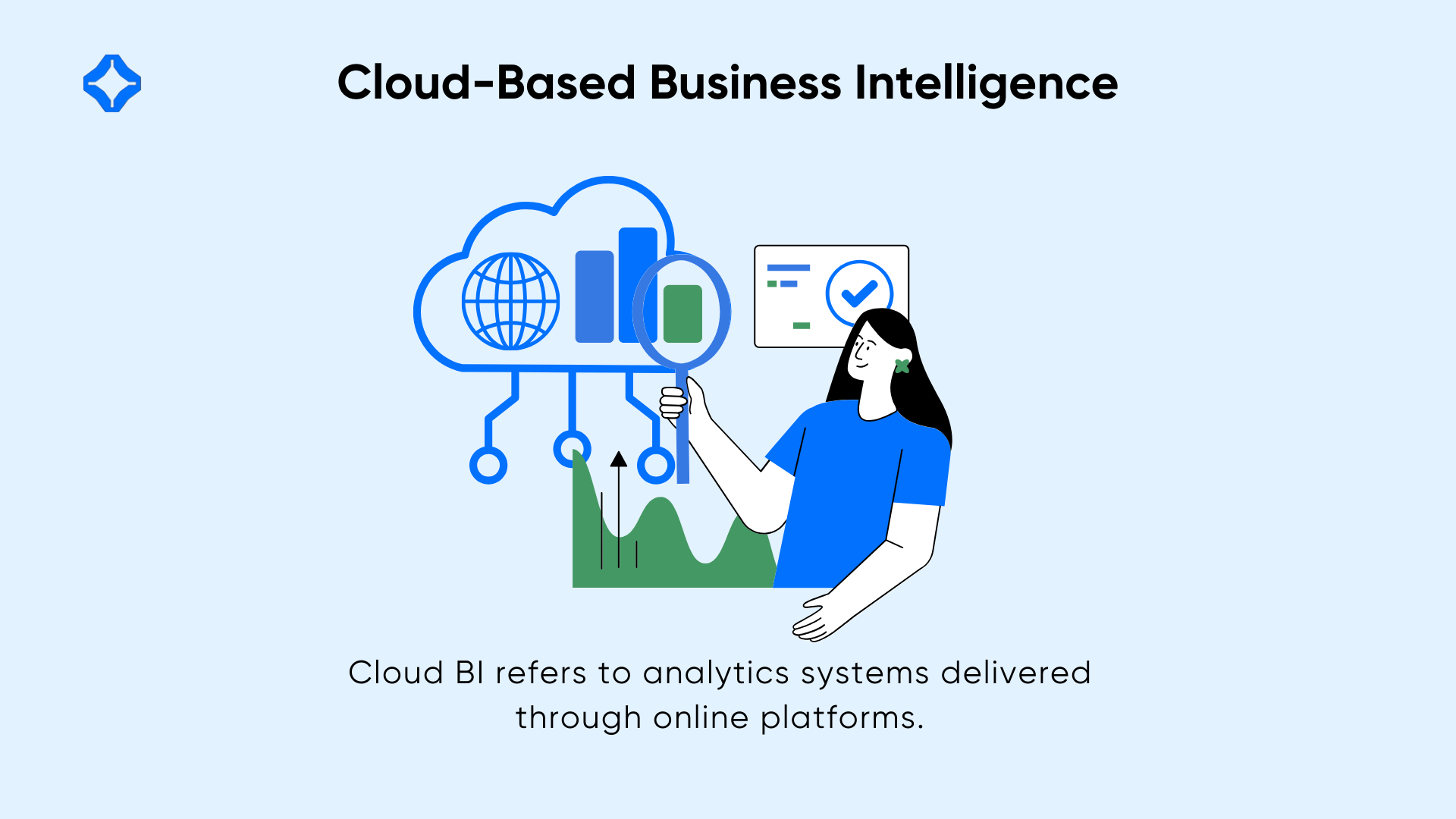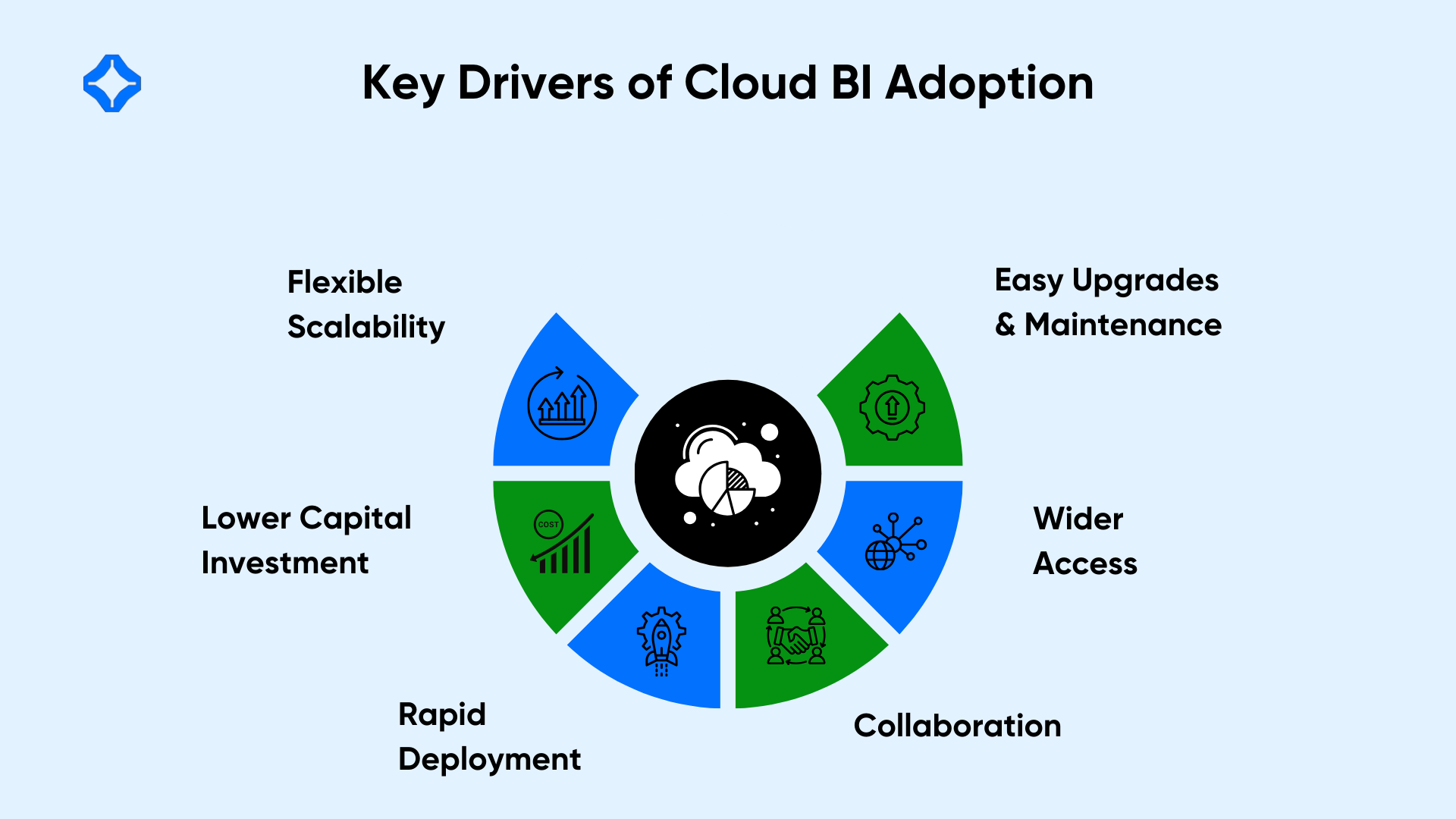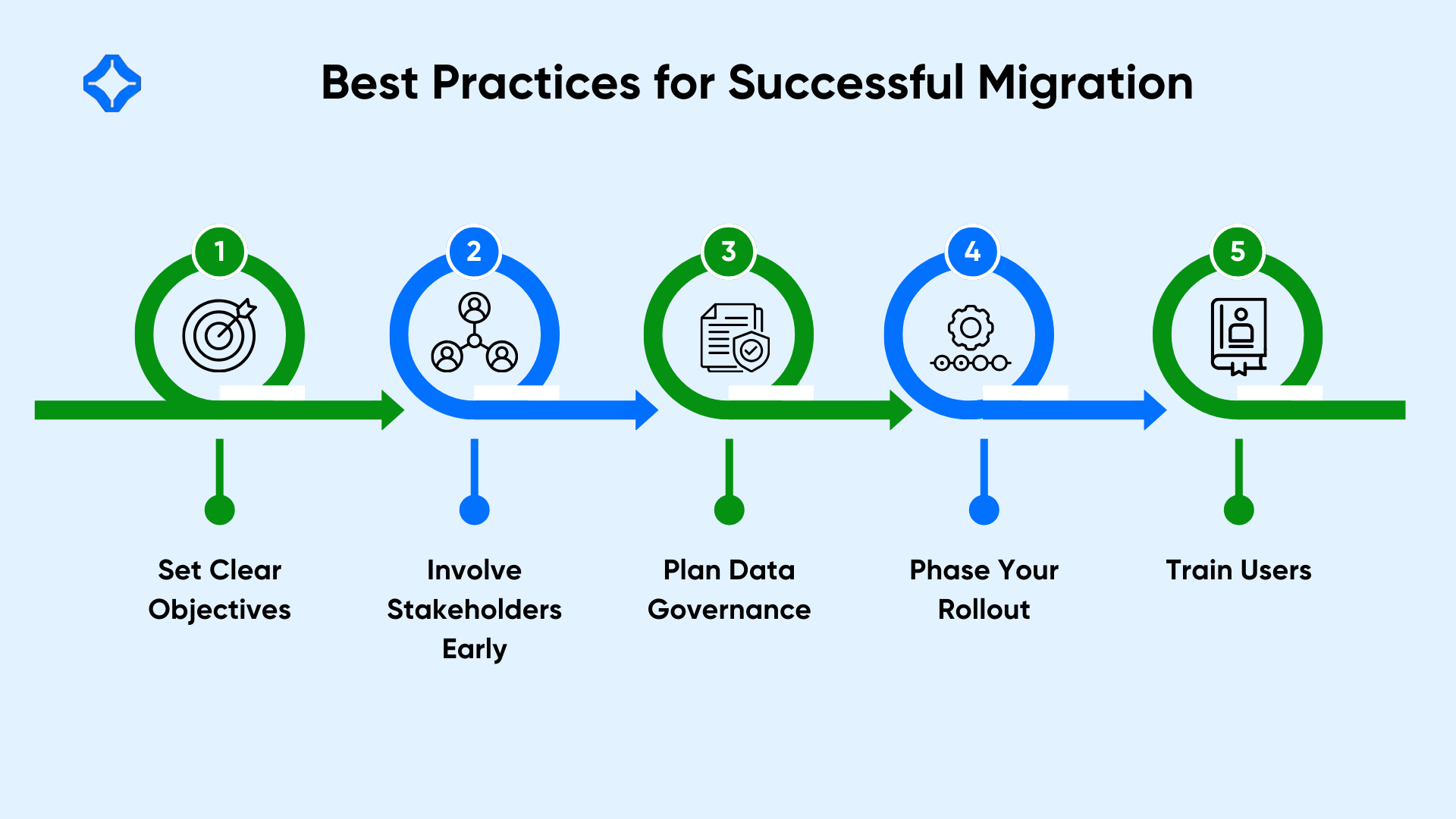Companies need fast real time insights to stay competitive. They gather data from daily transactions, customer interactions, and market trends. Interpreting this information becomes crucial for making better decisions. Many businesses now look to cloud-based business intelligence for speed, flexibility, and lower costs.
This article discusses why cloud-powered BI is gaining popularity. It explores the core reasons behind the shift and examines how these tools support better analysis. You will learn about the benefits, challenges, and best practices for adopting a cloud-based BI platform. By the end, you should see why so many firms are rethinking traditional BI approaches and moving to the cloud.
Understanding Cloud BI

Cloud BI refers to analytics systems delivered through online platforms. Instead of housing data tools on local servers, companies connect to a provider’s infrastructure. Users then access dashboards, reports, and visualizations through a web browser or similar interface.
This arrangement frees organizations from maintaining physical hardware. They subscribe to a service that handles upgrades, security patches, and performance tuning. This approach also allows teams to scale up or down depending on their data volume and usage demands.
Many providers offer a wide range of BI functions in the cloud. These include data ingestion, cleansing, modeling, and visualization. Some solutions even include machine learning SaaS for advanced forecasting or anomaly detection.
The Traditional BI Approach
Before the cloud became widespread, BI platforms typically ran on-site. Data warehouses, extraction tools, and visualization dashboards sat within company walls. Setting up these systems required significant investment in servers, software licenses, and specialized staff.
On-premise BI demanded ongoing maintenance and large upfront costs. If data volumes grew, more hardware was needed. If business units requested new analytics features, teams had to buy extra software modules. The entire process could be slow and expensive.
Updates and patches also fell under the client’s responsibility. Neglecting them created security gaps or performance issues. This model worked for some large enterprises, but it limited smaller organizations or those lacking IT resources.
Shifting Toward Cloud Solutions
As internet speeds and cloud infrastructures improved, many software services moved off local machines. BI followed this trend. Companies saw how cloud providers offered reliable networks, elastic computing power, and global data centers.
Early concerns about data security in the cloud gradually eased. Providers adopted encryption, multi-factor authentication, and compliance with industry standards. This allowed businesses in regulated sectors to consider cloud options. Over time, the success stories and cost savings became too compelling to ignore.
Now, cloud BI is no longer a fringe idea. It is a core strategy for firms of all sizes. New startups and established players both rely on external servers and modern analytics stacks. This unlocks robust insights without heavy infrastructure burdens.
Key Drivers of Cloud BI Adoption

1. Flexible Scalability
Data volumes can spike abruptly. A new marketing campaign or seasonal surge might multiply record counts. With cloud BI, teams do not scramble to buy new servers. The cloud automatically adjusts computing resources, so performance remains steady even during data peaks.
Businesses only pay for what they use. When traffic is low, systems dial back to save costs. This elasticity appeals to organizations with fluctuating workloads or uncertain growth patterns.
2. Lower Capital Investment
Local BI installations involve considerable upfront expenses. Companies must purchase hardware, databases, and management tools. Cloud BI replaces this capital outlay with monthly or annual subscription fees. This model preserves cash flow for other strategic areas.
Decision-makers see immediate returns once the subscription starts. They do not wait for lengthy setup cycles. Budgeting becomes simpler since costs show up as predictable operating expenses. Financial predictability and quick deployment both add to the cloud’s appeal.
3. Rapid Deployment
On-site BI can take months to fully implement. Hardware may need shipping, racking, and configuration. Teams must install software, integrate data sources, and test performance. Mistakes along the way can delay the entire project.
Cloud BI streamlines these tasks. Providers handle the hosting environment. Users log into a secure portal, connect data sources, and begin creating dashboards. Teams often launch proof-of-concept projects in days or weeks. This swift pace delivers insights faster, which fosters trust in the BI initiative.
4. Easy Upgrades and Maintenance
In a local setup, upgrades call for downtime and expert attention. Missing important patches can leave systems exposed. Cloud BI removes that hassle. The service provider handles updates in the background with minimal interruption.
Companies also avoid lengthy upgrade negotiations with vendors. Everyone benefits from the latest version, which typically includes new features and security fixes. This constant evolution helps analytics stay relevant and user-friendly.
5. Widened Access and Collaboration
A cloud-based BI platform is reachable from any internet-connected device. Sales reps on the road or branch managers in remote offices can log in and view dashboards. Distributed teams share the same real-time dataset, reducing confusion about older versions.
This approach supports collaboration across departments. A marketing director can build a dashboard and invite finance or operations to discuss trends. Feedback loops become faster because everyone sees the same numbers at the same time. This synergy often leads to better strategies and deeper insights.
Common Use Cases
Business Performance Monitoring
Executives rely on timely metrics. Cloud BI pulls data from enterprise apps and delivers live dashboards. Leaders track revenue, orders, or customer churn without waiting on static reports. This helps them identify issues early and respond to market changes.
Sales and Marketing Analytics
Sales teams study pipeline activity, deal conversion rates, and territory performance. Marketers examine campaign engagement, cost per lead, and return on ad spend. Cloud platforms unify these data points in a cohesive view, making it simpler to spot patterns.
Supply Chain Optimization
Efficient logistics keeps costs down and customers satisfied. A cloud BI tool can merge data from inventory systems, transportation providers, and demand forecasts. Warehouse managers identify bottlenecks and forecast stock needs. This leads to better resource allocation.
Customer Behavior Insights
E-commerce companies often track click patterns, cart abandonment, and user demographics. Cloud-based analytics make it easy to generate segments or funnel reports. This helps teams refine product offerings or user experiences. Over time, the data helps refine strategic decisions.
Security Considerations
Cloud Security is critical whenever data leaves on-site facilities. Cloud BI providers use encryption, multi-tenant isolation, and access controls to protect information. Many hold certifications for data privacy and follow strict governance policies.
Clients should review their vendor’s credentials and compliance track record. A reputable provider will outline how they safeguard data at rest and in transit. They may also offer features like role-based permissions, which limit who can see or modify certain datasets.
Internal best practices also matter too. Even the most secure vendor cannot help if a customer uses weak passwords or fails to follow data protection policies. Training staff on secure logins and data handling can avert many breaches.
Challenges in Cloud BI Adoption
Data Integration Complexities
Large enterprises store information in numerous systems. Moving these sources into a single cloud environment can be tricky. Mergers and acquisitions sometimes leave a tangle of outdated databases. Cleansing and unifying this data takes effort, especially if the business does not have a data governance strategy in place.
Some organizations choose a phased approach. They begin with a few critical datasets, prove value, and then expand. This incremental path helps them handle the complexities step by step.
Internet Connectivity
Cloud services depend on stable internet connections. Sluggish networks can hamper performance, especially with large data queries. In some regions, outages or limited bandwidth may disrupt normal operations. Local caching or hybrid strategies can reduce these risks, but connectivity remains a factor when considering cloud analytics.
Vendor Lock-In Concerns
After building analytics on one platform, switching providers can be costly. Tools may rely on proprietary data storage formats or query languages. Teams also grow comfortable with a specific user interface. Over time, they might fear losing progress if they decide to change vendors.
Organizations can address this by choosing vendors who support open standards. Another strategy is to keep raw data in a portable format. This way, they retain some freedom to switch or integrate with other solutions.
Best Practices for Successful Migration

Start with Clear Objectives
A shift to cloud BI should stem from well-defined goals. Are you aiming for faster reports, better collaboration, or reduced expenses? Knowing the main reason guides your vendor selection. It also helps measure outcomes after deployment.
Involve Stakeholders Early
Department heads, data analysts, and IT specialists may have different priorities. By involving them from the start, you get a fuller picture of the requirements. This also boosts buy-in when changes happen. People who have a say in selecting the platform are more likely to use it effectively later.
Plan Data Governance
Data governance ensures consistent formatting, naming conventions, and security rules. Good governance avoids confusion about which data is the official source. It also outlines how often data is updated and who can modify specific elements. Cloud BI tools depend on reliable data pipelines, so clarity here is vital.
Phase Your Rollout
Some organizations try to deploy everything at once and run into problems. A better approach is to migrate a specific department or use case first. This smaller rollout identifies potential issues without impacting the entire enterprise. Early wins generate momentum and help refine processes before scaling up.
Train Users
Moving to a new analytics environment can unsettle employees. Provide tutorials, workshops, or e-learning modules on how to create dashboards or run queries. Encourage knowledge sharing so experienced users can guide newcomers. Continual learning raises adoption rates and fosters a data-focused culture.
Future Outlook for Cloud BI
Demand for real-time analytics will likely grow. Automated pipelines, stream processing, and edge computing all feed into cloud BI platforms. Providers aim to handle bigger data volumes faster, using technologies like in-memory databases and distributed clusters.
Artificial intelligence features also appear set to expand. Predictive analytics, anomaly detection, and smart alerts will become standard. Users may receive automated suggestions instead of manually building queries. Such advancements reduce the skill barrier to gleaning insights from large datasets.
Hybrid models may emerge more frequently. Some data might remain on-site for compliance or latency reasons, while other processes run in the cloud. Vendors will likely refine how these hybrid setups function. This flexibility allows businesses to keep sensitive or regulated information local while still tapping into cloud efficiencies.
Conclusion
Cloud-based BI tools have become integral for modern analytics. The ability to scale resources, reduce costs, and deploy quickly attracts firms of every size. By freeing teams from hardware headaches, these services allow them to focus on meaningful insights.
Though potential hurdles exist, such as data integration or vendor lock-in, many companies find the rewards outweigh the risks. Successful transitions often rely on planning, training, and clear goals. Overcoming these challenges leads to faster decision-making, collaborative insights, and a data-driven culture.
Cloud-based BI continues to evolve. Ongoing advances in AI, workflow automation, and integration will likely strengthen its foothold. For companies seeking a competitive edge, adopting these platforms seems less a gamble and more a strategic necessity. By embracing the cloud, businesses gain powerful tools to interpret real-time data and act with greater confidence.
FAQs
Reputable cloud BI providers use strong security measures, including encryption and strict access controls. However, organizations must confirm the vendor’s certifications and apply internal policies such as secure logins and data governance to reduce risks.
Upfront hardware costs vanish and are replaced by subscription fees. This model can be more predictable and scalable. Businesses pay for what they use and can adjust resources as workloads shift. This often leads to savings if managed well.
Cloud platforms simplify administration, so less in-house expertise may be required. Still, a team should handle tasks like data mapping, user training, and ongoing monitoring. Their role focuses on strategy and data quality rather than hardware upkeep.